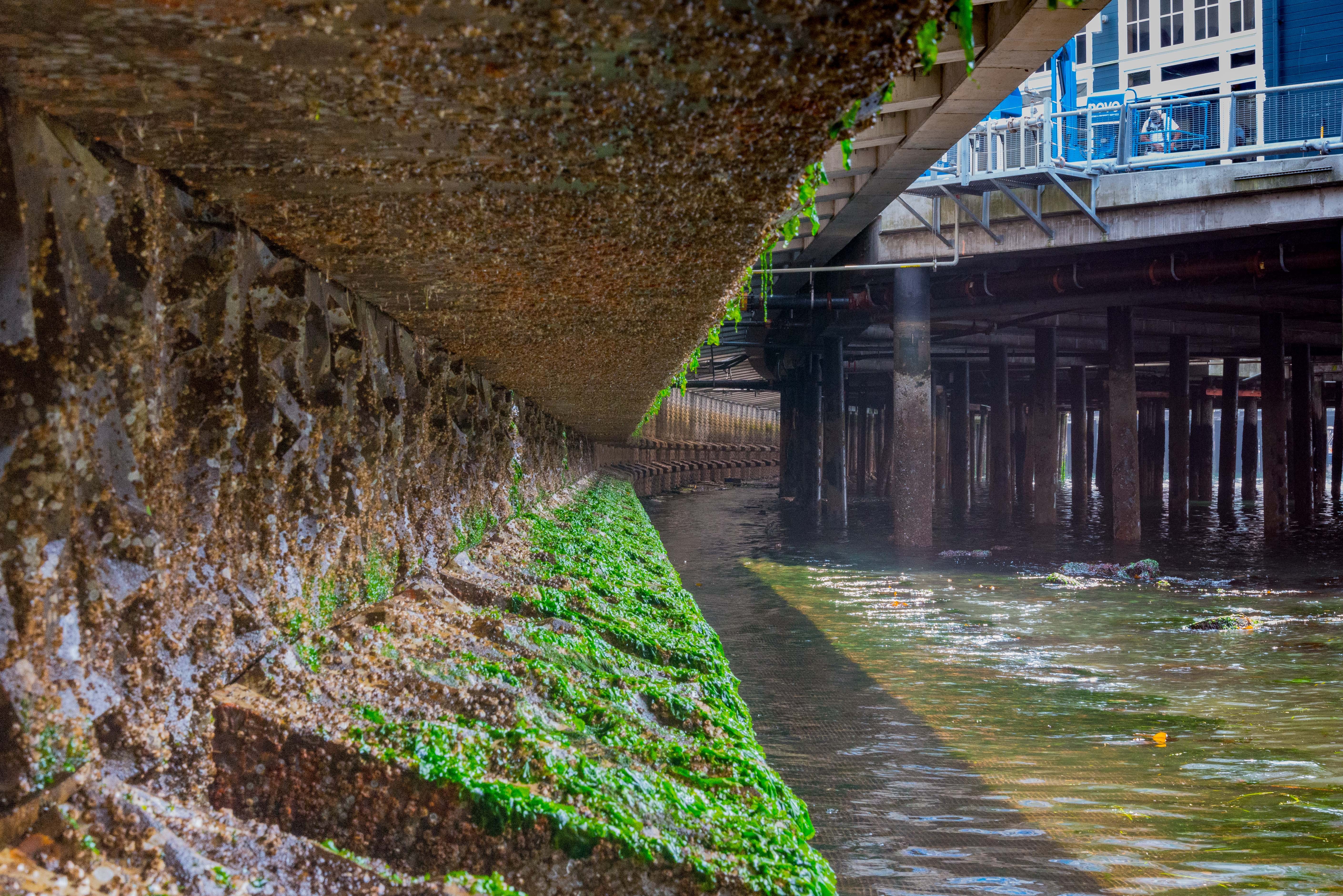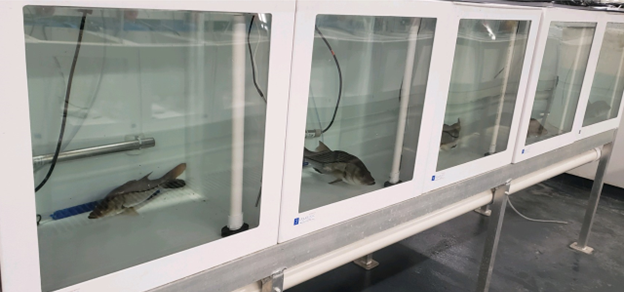- About
- Affiliates
- Join
- Publications
- Estuaries and Coasts
- CERF's Up! Quarterly Bulletin
- Coastal & Estuarine Science News (CESN)
- CERF-Lit
- Advertising
- Programs & Events
- Inclusive Culture
- Communities
Coastal & Estuarine Science News (CESN)The mission of Coastal & Estuarine Science News (CESN) is to highlight the latest research in the journal Estuaries and Coasts that is relevant to environmental managers. It is a free electronic newsletter delivered to subscribers on a bi-monthly basis. Sign up today! 2025 Issue 2Table of ContentsAdding Life to Hardened Urban Shorelines
Testing Cold Hardiness in Tropical Fish Tidal Flooding Contributes Significantly to Eutrophication How Do Human Communities Benefit from Restoration? Adding Life to Hardened Urban Shorelines Living seawalls can offer some of the benefits of living shorelines
Shoreline armoring projects can increase structural complexity by incorporating design elements such as seawall texturing (including the addition of grooves and crevices), habitat benches that provide shallow habitat for marine organisms, or submerged structures like artificial reefs. These added structural components help to increase biodiversity and can attract nekton such as fish and large crustaceans. Living seawalls also allow people to simply connect with the sea and can provide a serene location to observe wildlife and nature. Current examples of urban projects that use hardened structures to enhance ecosystem services come from just a few manufacturers and practitioners. These include the Seattle Seawall for salmon habitat restoration; the Living Seawalls Project, which has goals of increasing biodiversity on multiple continents; the Reef Design Lab, which is developing marine habitat infrastructure; and ECOncrete Projects, which is working to increase biodiversity and sequester carbon. But critical information is still needed to properly design urban shorelines and to best customize basic techniques for local conditions. Source: Grothues, T.M. et al. 2025. Life as a Design Element of Hardened Urban Shorelines. Estuaries and Coasts. DOI: 10.1007/s12237-024-01475-z Image: Habitat shelf on the Elliott Bay Seawall / City of Seattle Testing Cold Hardiness in Tropical Fish All hail the snook in the north
Researchers wanted to see if the thermal tolerance of populations at the leading edge of expansion was different than those within their traditional range. They collected snook from four coastal riverine systems that included populations across their historical, transitional, and expanded ranges. Individual fish were placed in experimental tanks and the water temperature was gradually decreased by 1°C per day to replicate the gradual onset of a 2010 cold event. To simulate a rapid cold event from 2008, the team lowered the water temperature by 1°C every two hours until loss of equilibrium was observed. Overall, snook followed a latitudinal pattern in their cold hardiness. Greater cold tolerance was observed in northern range-expanded populations, ceasing feeding at 14.4°C and exhibiting mortality at 8.6°C. In comparison, those from the site furthest south stopped feeding first (16.1°C) and died at warmer temperatures (9.2oC). Furthermore, snook were more susceptible to a rapid cold event than a gradual one. These findings highlight the importance of understanding cold tolerance and underscore how the same cold thresholds do not necessarily apply to an entire species. Metrics like these can be used to model range expansion of tropical populations and help target management approaches. In this case, information on thermal refugia is being taken into account for setting minimum freshwater flows and levels in Florida estuaries. Source: Hall‑Scharf, B.J. et al. 2025. Increased Cold Tolerance of a Tropical Fish Species at the Northern Edge of Its Expanded Range. Estuaries and Coasts. DOI: 10.1007/s12237-024-01480-2 Image: Snook in insulated tanks / Brittany Scharf Tidal Flooding Contributes Significantly to Eutrophication Quantifying tidal surge flooding in the Chesapeake Bay During tidal flooding in urban areas, water can pick up nutrients from the land before returning to estuarine and coastal waters. Extreme high tide flooding events have increased in recent years and are predicted to become more frequent and intense, and the associated nutrient loads can be substantial. In the Chesapeake Bay, although critical progress has been made to reduce both point and nonpoint sources of nutrients, tidal flooding isn’t included in the models currently used to set Total Maximum Daily Loads (TMDLs), which are being used to help improve water quality in the bay and its tributaries. Researchers wanted to build a statistical model to predict nutrient loading to adjacent water bodies resulting from tidal flooding events. They measured dissolved inorganic nitrogen and phosphorus concentrations in retreating floodwater during 15 tidal flooding events occurring in all seasons between January 2019 and September 2020 at seven sentinel sites that experience frequent tidal flooding within Virginia’s Lafayette River watershed at the southern end of the Chesapeake. These flood concentrations were compared to publicly available data collected prior to each tidal flooding event for each site; this allowed them to calculate the differences between floodwater and estuarine concentrations (delta DIN and delta DIP). The team then looked for correlations between either delta DIN or delta DIP and a variety of metrics, including meteorological conditions and land use and cover. All sites showed statistically higher DIN and DIP concentrations in retreating floodwater compared to estuarine receiving waters. Although there were no correlations with elevation or land use, delta DIN was strongly correlated with water temperature and the level of high waters during flood events; delta DIP was strongly correlated with water temperature and the average wind speed on the day of the flooding event. The researchers estimated loads of dissolved nutrients delivered during tidal flooding by multiplying delta DIN and delta DIP by inundation volume for each event (based on NOAA data). Their results show that nutrient loading from these events alone exceeded annual load allocations established by the EPA for the Lafayette River. Furthermore, these loads have increased in recent years as tidal flooding has become more common. This will only worsen as sea level continues to rise, so the authors argue strongly for including nutrient inputs from tidal flooding when setting TMDLs. Source: Macías‑Tapia, A. et al. 2024. Tidal Flooding Contributes to Eutrophication: Constraining Nonpoint Source Inputs to an Urban Estuary Using a Data‑Driven Statistical Model. Estuaries and Coasts. DOI: 10.1007/s12237-024-01473-1 How Do Human Communities Benefit from Restoration? Shifting strategies for assessing long‑term benefits of restoration projects To more effectively plan for future coastal restoration projects, managers and communities alike need to know what kinds of benefits existing projects provide to communities. Yet, research on societal impacts is scarce. After conducting a literature review and finding little data on community impacts of restoration, a team of researchers collected qualitative data from community members in Louisiana through a social science data collection method known as History Harvests. Louisiana, which has had a coastal master plan since 2007, is often cited as an example for how sea–level rise will affect communities and how states can respond. Community members were invited to site visits where they were presented with information about the restoration projects that had been done; 41 participants were interviewed before and after attending site tours. Based on their findings, the researchers suggest examining how restoration projects impact not just ecosystem services, but also economic activities (like job creation) and community capital (including groups that are more vulnerable to hazards of climate change). The interviews revealed that, due to the challenges of visiting restoration sites, people valued the opportunity to see, ask questions, and make more informed decisions about the benefits of restoration projects in their community—but there are some disconnects. Some were unclear about whether projects actually accomplish the promised tasks, and for those who previously participated in the planning process, there was limited post-construction follow up. Many also felt that their own local knowledge might not be the same as the information used by decision makers. The authors conclude that ecological targets shouldn’t be the only focus for restoration projects: Involving community members provides critical support for restoration in the long term. With local participation, useful and informed feedback—beginning at a project’s conception and continued throughout its lifespan—can help improve hazard mitigation planning efforts and ultimately build resilience to future climate risks. Source: Osland, A.C. et al. 2025. Did It Work? Shifting Strategies for How We Assess Benefits to Communities from Long‑Term Coastal Restoration Projects. Estuaries and Coasts. DOI: 10.1007/s12237-025-01486-4 |


